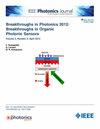Quadratic Vortex Optical Pin Beam With OAM Mode Anti-Degradation Characteristic
IF 2.1
4区 工程技术
Q3 ENGINEERING, ELECTRICAL & ELECTRONIC
引用次数: 0
Abstract
Orbital angular momentum (OAM) signal mode crosstalk and energy loss induced by atmospheric turbulence are challenging phenomena commonly occurring in high-capacity and high-speed OAM-based free-space optical communications. In this paper, we combine the optical pin beam (OPB) that resists atmospheric turbulence with the quadratic vortex phase (QVP) to realize a communication transmission beam based on weakening the degradation of the OAM signal mode. The probability densities of a single OAM mode of an optical pin vortex beam carrying a QVP (QVP-OPVB), after passing through an anisotropic non-Kolmogorov turbulent atmosphere, are theoretically derived. Through numerical simulation, it is found that QVP can be regarded as a superposition of multiple OAM modes, and the energy transfer between OAM modes during the propagation can compensate for the degradation of the OAM spectrum caused by atmospheric turbulence. Compared to the OAM spectra of the Gaussian vortex beam carrying QVP (QVP-GVB), the QVP-OPVB has better anti-crosstalk performance in a turbulent environment with a long propagation distance and a small receiving aperture. This beam has applications in free-space optical communication to enhance the interference resistance of the communication link.求助全文
约1分钟内获得全文
求助全文
来源期刊

IEEE Photonics Journal
ENGINEERING, ELECTRICAL & ELECTRONIC-OPTICS
CiteScore
4.50
自引率
8.30%
发文量
489
审稿时长
1.4 months
期刊介绍:
Breakthroughs in the generation of light and in its control and utilization have given rise to the field of Photonics, a rapidly expanding area of science and technology with major technological and economic impact. Photonics integrates quantum electronics and optics to accelerate progress in the generation of novel photon sources and in their utilization in emerging applications at the micro and nano scales spanning from the far-infrared/THz to the x-ray region of the electromagnetic spectrum. IEEE Photonics Journal is an online-only journal dedicated to the rapid disclosure of top-quality peer-reviewed research at the forefront of all areas of photonics. Contributions addressing issues ranging from fundamental understanding to emerging technologies and applications are within the scope of the Journal. The Journal includes topics in: Photon sources from far infrared to X-rays, Photonics materials and engineered photonic structures, Integrated optics and optoelectronic, Ultrafast, attosecond, high field and short wavelength photonics, Biophotonics, including DNA photonics, Nanophotonics, Magnetophotonics, Fundamentals of light propagation and interaction; nonlinear effects, Optical data storage, Fiber optics and optical communications devices, systems, and technologies, Micro Opto Electro Mechanical Systems (MOEMS), Microwave photonics, Optical Sensors.
 求助内容:
求助内容: 应助结果提醒方式:
应助结果提醒方式:


